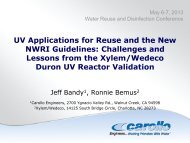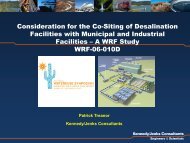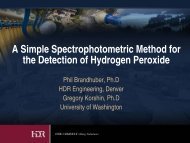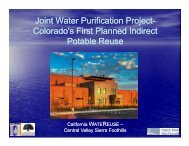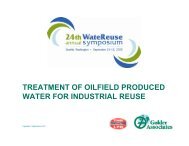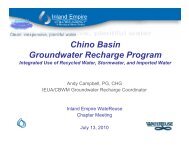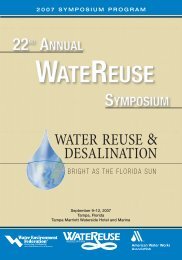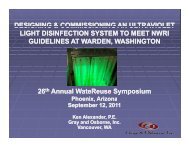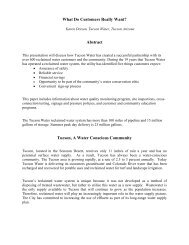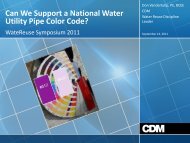Desalination Plant Intakes - WateReuse Association
Desalination Plant Intakes - WateReuse Association
Desalination Plant Intakes - WateReuse Association
You also want an ePaper? Increase the reach of your titles
YUMPU automatically turns print PDFs into web optimized ePapers that Google loves.
energy consumption is achieved at a membrane flux of 9.0 gallons per square feet per day (gfd)and RO system recovery of 48% 13 .Most desalination plants collect 4 to 10% of additional water to wash their pretreatment filtrationsystems and discharge the spent filter backwash water back to the ocean. A design approachwhich may allow reducing this water use significantly is treatment and reuse of the backwashwater. Such a backwash treatment and reuse approach has cost implications but is a prudentdesign practice aimed at reducing overall plant seawater intake flow and associated impingementand entrainment.Collecting additional seawater for concentrate pre-dilution may be needed when existingwastewater intake or power plant outfalls are used for concentrate discharge and the existingoutfall volume is not sufficient to produce adequate dilution of the saline discharge. Thisadditional flow intake could be eliminated by designing facilities for storing concentrate duringperiods of low outfall flows when adequate dilution is not available, or by installing a dischargediffuser system which allows enhancing concentrate dissipation into the ambient marineenvironment without additional dilution.If the desalination plant production capacity has to vary diurnally, the design and installation ofvariable frequency drives on the intake pumps could also allow decreasing impingement andentrainment of the plant intake by closely matching collected source seawater volume to theplant production needs.Use of Low-Impact Intake TechnologiesImpingement and entrainment of marine organisms could be minimized by using varioussubsurface and open intake technologies. Currently, there are no federal and state regulationswhich specifically define requirements for reduction of impingement and entrainment caused bydesalination plant intakes. However, the US EPA Section 316(b) of the Clean Water Act federalregulations have stipulated national performance standards for intake impacts from powergeneration plants which require 80 to 95% reduction of impingement and 60 to 90% reduction ofentrainment as compared to those caused by uncontrolled intake conditions 14 . Technologies thatcan meet these impingement and entrainment performance standards are defined by US EPA asBest Technology Available (BTA).Subsurface <strong>Intakes</strong>Subsurface intakes (vertical and horizontal directionally drilled wells, slant wells and infiltrationgalleries) are considered a low-impact technology in terms of impingement and entrainment.However, to date there are no studies that document the actual level of entrainment reduction that13 http://www.affordabledesal.com/home/news/ADC%20Completes%20Profile%20of%20SWRO%203-28-08.pdf14 http://edocket.access.gpo.gov/cfr_2008/julqtr/pdf/40cfr125.94.pdfSeawater <strong>Desalination</strong> <strong>Plant</strong> <strong>Intakes</strong> – Impingement and Entrainment Page 9




